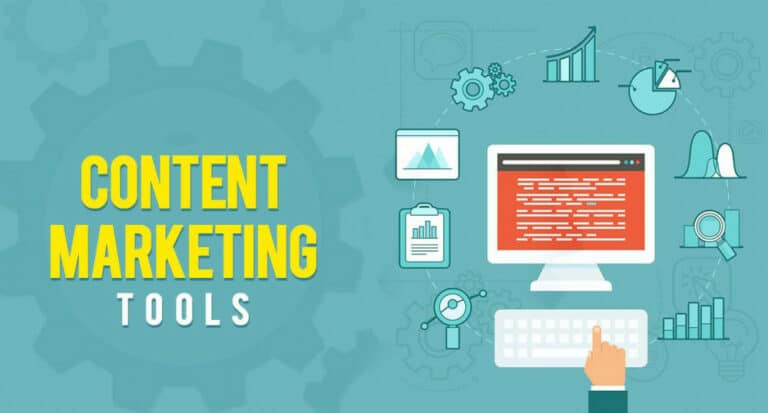Marketing Attribution Model
Marketing Attribution Model That Drives Real Results Fast
Understanding where your leads and sales come from is essential in today’s competitive landscape. A marketing attribution model helps you pinpoint which channels drive results so you can optimize your strategy.
Whether you're a digital marketer or business owner, learning how attribution works gives you a clear path to higher ROI and smarter decisions. In this blog, we’ll explore how to choose and measure the best attribution model.
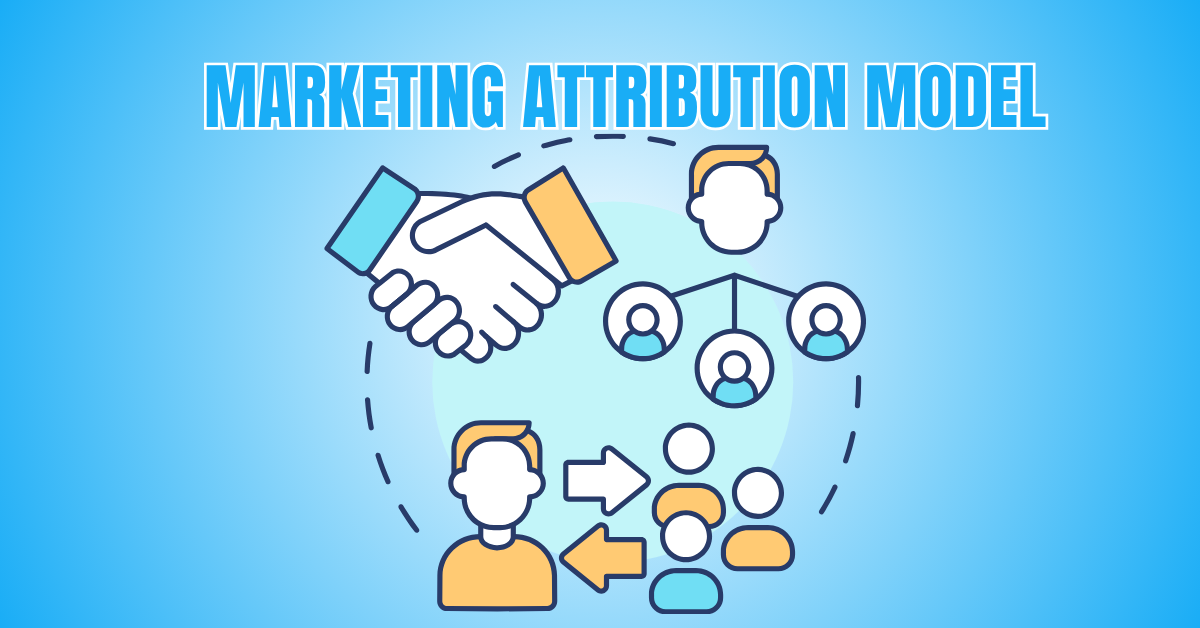
What Is Marketing Attribution?
Marketing attribution is the process of determining which touchpoints and marketing channels led to a sale or conversion.
It helps marketers determine how credit for sales and conversions is assigned to various interactions across a customer’s journey.
By understanding which channels or strategies drive results, businesses can allocate resources more effectively, reduce wasteful spending, and improve ROI.
There are different models of attribution, such as first-touch, last-touch, linear, and data-driven. Each assigns credit differently based on the type of customer journey and campaign goals.
Attribution helps uncover what combination of channels—email, paid ads, organic search, social media—lead to meaningful outcomes.
Types of Marketing Attribution Models
Marketing attribution models help businesses understand which touchpoints drive conversions. By assigning credit to different interactions, these models guide better decisions, optimize budgets, and improve overall marketing effectiveness.
1. First-Touch Attribution Model
According to the First-Touch Attribution Model, a customer's initial touch with your brand receives 100% of the conversion credit.
It focuses on the origin of a lead, such as a social media ad, blog post, or Google search that first brought them into your funnel.
This model is helpful in understanding which marketing channels are best for creating awareness and attracting new leads. Its ease of use and capacity to emphasize top-of-funnel performance are its primary advantages.
However, it fails to recognize the influence of any subsequent touchpoints, making it less effective for long or complex buyer journeys.
It works best for businesses prioritizing lead generation or brand awareness over engagement and nurturing phases.
2. Last-Touch Attribution Model
The Last-Touch Attribution Model assigns 100% of the credit to the final touchpoint before the customer converts. This could be a retargeting ad, email campaign, or direct website visit that occurred just before purchase.
It’s beneficial for analyzing which actions directly led to conversion. This model's simplicity makes it simple to use and understand.
However, it completely ignores the earlier steps that helped build trust and nurture the lead. It’s not ideal for companies with long sales cycles or multi-channel marketing strategies.
Still, it works well for short funnel journeys or when you're optimizing final-stage marketing activities like checkout incentives or follow-up emails.
3. Linear Attribution Model
The Linear Attribution Model divides credit for a conversion equally across all the touchpoints a customer interacted with along their journey.
If a customer had five engagements before converting, each touchpoint would receive 20% credit. This model provides a more balanced view of how different channels contribute to a sale, recognizing that each step plays a role.
It’s particularly effective for businesses with long sales cycles where multiple campaigns contribute to the conversion.
However, it doesn’t weigh the importance or impact of each interaction, which can lead to an inaccurate representation of what truly influenced the decision.
This model is suitable when you want a simple overview that treats all engagements as equally important.
4. Time-Decay Attribution Model
In the Time-Decay Attribution Model, touchpoints that take place closer to the conversion are given greater weight. Earlier interactions receive less credit, while those near the final conversion point receive more.
This model reflects the logic that actions closer to a purchase are more influential. It’s great for businesses with long sales cycles or multiple nurturing steps, as it emphasizes recent marketing efforts.
A significant advantage is its realistic approach to customer decision-making, especially in the final stages. However, it undervalues top-of-funnel marketing, like awareness campaigns, which are essential for introducing your brand.
It also requires proper tracking and analytics tools, making it more complex than simpler attribution models.
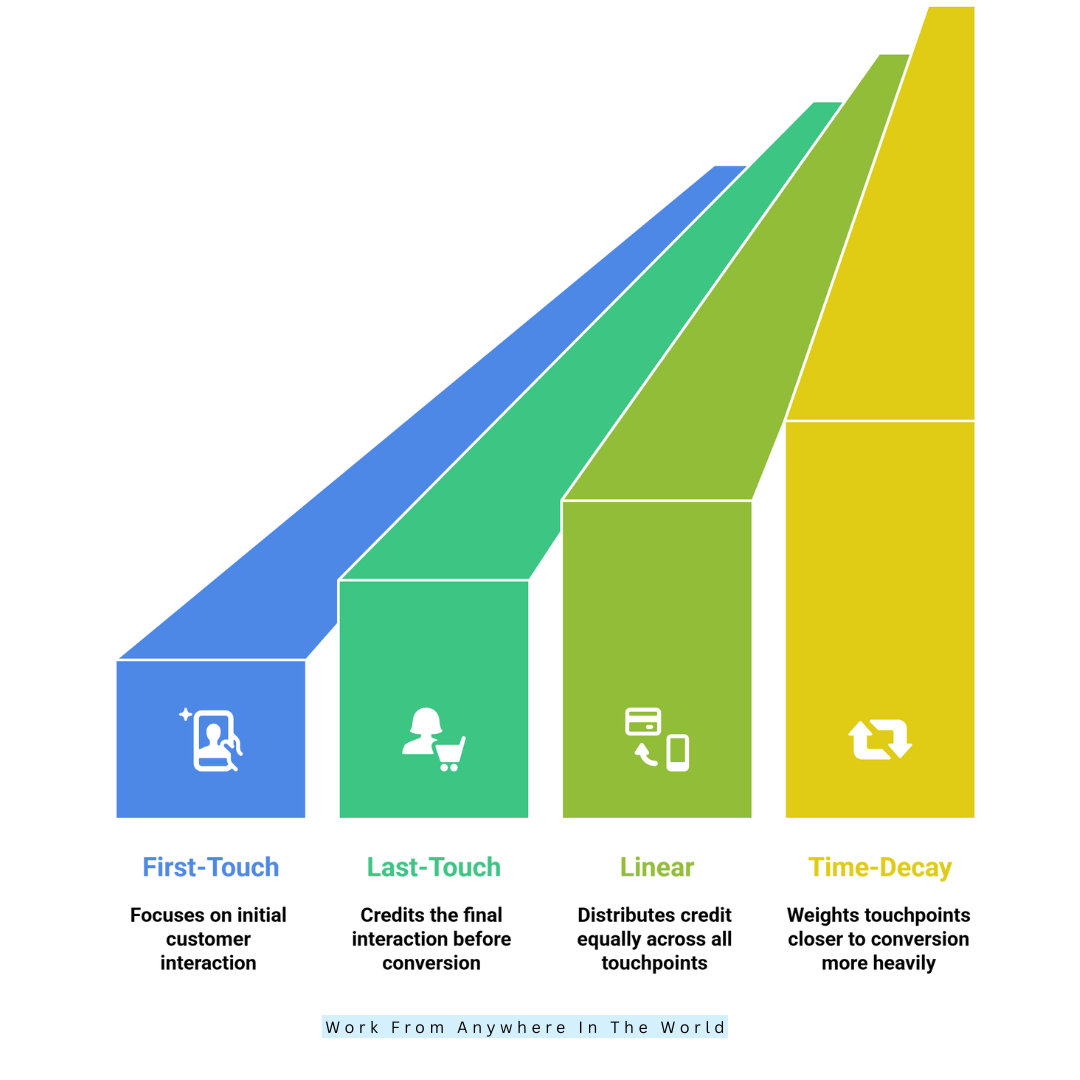
5. Position-Based (U-Shaped) Attribution Model
The Position-Based (U-Shaped) Attribution Model gives 40% credit each to the first and last touchpoints. The remaining 20% is evenly shared among all middle interactions.
This model emphasizes the importance of how the customer first discovers your brand and what finally drives them to convert. It’s ideal for businesses that value both lead generation and closing performance.
It provides a more realistic picture than single-touch models while still being simple to apply. However, the percentage split is arbitrary and may not accurately reflect actual influence.
It can also undervalue nurturing interactions in the middle of the journey. Still, it’s a good compromise for companies seeking balanced yet easy-to-implement attribution.
6. W-Shaped Attribution Model
The W-Shaped Attribution Model is a step up from the U-Shaped model, giving 30% of the conversion credit to three key milestones: the first interaction, the lead conversion point, and the final conversion touch.
The remaining 10% is divided among other touchpoints. This model is particularly useful for B2B businesses and long sales cycles where multiple key steps occur before the deal closes.
It provides a deeper view of the entire funnel by acknowledging lead generation, nurturing, and conversion. However, it’s more complex to track and may still leave out some important touchpoints.
Additionally, like the U-Shaped model, the percentage allocation is fixed and might not fit every business. It works well when lead qualification is a critical phase.
7. Full-Path Attribution Model
The Full-Path Attribution Model builds on the W-Shaped model by including the sales team’s contribution in the attribution process.
Credit is distributed evenly among the first touchpoint, lead conversion, opportunity creation, and final conversion, with remaining credit spread across other engagements.
This model is ideal for organizations where both marketing and sales play active roles in converting leads, particularly in B2B environments.
It provides a comprehensive view of the whole customer journey, enabling better alignment between marketing and sales. However, this model is highly complex and requires advanced CRM integration, marketing automation, and precise tracking.
It may be overwhelming for small businesses, but it is incredibly valuable for enterprises focused on optimizing the entire sales funnel.
8. Custom Attribution Model
The Custom Attribution Model is explicitly tailored to your business goals and buyer behaviour. It allows marketers to assign weights to touchpoints based on performance, data insights, or predictive analytics.
This model can be rule-based or powered by machine learning. Its biggest advantage is flexibility and accuracy, providing a truly reflective view of what drives conversions in your unique environment.
It enables better resource allocation and campaign optimization. However, it requires significant time, data, and expertise to build and maintain.
Without the right analytics tools and data quality, it can lead to incorrect insights. It’s best suited for large companies or digital-first businesses that want precise control over their marketing measurement.
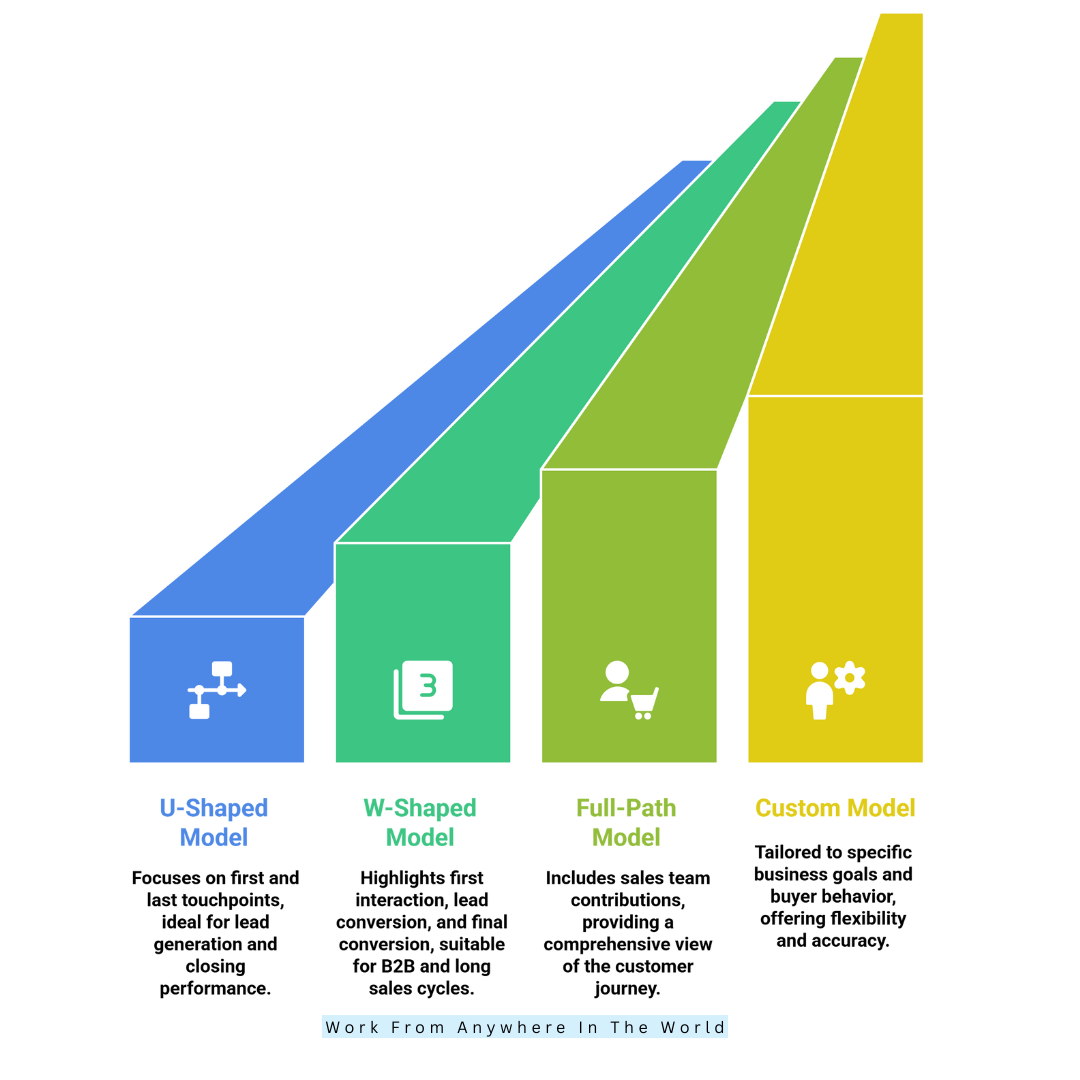
How To Measure Marketing Attribution
Marketing attribution measurement reveals which marketing efforts drive conversions. By tracking touchpoints and analyzing data, businesses can optimize campaigns, allocate budgets wisely, and improve overall return on investment (ROI).
1. Define Your Conversion Goals Clearly
Before measuring attribution, you must establish what a “conversion” means for your business. It could be a product purchase, a newsletter sign-up, or a demo request.
Defining the goal ensures every data point collected has purpose and context. Different goals may require different attribution models.
For example, eCommerce may focus on sales, while SaaS companies might track trial sign-ups or onboarding completions. Be specific—include the expected user actions, timeframes, and value of the conversion.
A well-defined goal creates a benchmark to analyze success across all marketing touchpoints and supports better performance tracking and campaign evaluation.
2. Map The Entire Customer Journey
It's crucial to comprehend how consumers engage with your company from initial contact to conversion. Start by identifying all marketing channels involved—ads, emails, social media, SEO, referrals, webinars, etc.
Then, determine how users engage at each stage: discovery, consideration, and decision. This map helps you see which touchpoints are meaningful, which are underperforming, and where users drop off.
The clearer your journey mapping, the easier it is to align attribution data. Customer journey maps form the foundation for choosing attribution models and help you see where engagement happens—and more importantly—how it leads to action.
3. Choose The Right Attribution Model
Attribution models define how credit is assigned to various touchpoints. Popular models include First-Touch, Last-Touch, Linear, Time-Decay, U-Shaped, and Data-Driven.
Each has its benefits depending on business goals and journey complexity. First-touch models prioritize awareness, while last-touch models focus on conversions.
Time decay is better for long sales cycles, and data-driven attribution gives the most accurate insights using machine learning. Choosing the right model helps you evaluate the true value of each touchpoint.
You may also compare multiple models side-by-side to see how attribution weights shift across different campaign strategies or customer segments.
4. Use UTM Parameters For Campaign Tracking
UTM parameters are simple tags added to URLs to track campaign performance more accurately in analytics tools. They reveal which traffic sources—like emails, social posts, or paid ads—drive conversions.
Use standardized naming for “source,” “medium,” and “campaign” to avoid confusion and make reporting cleaner. Tools like Google Analytics then group traffic by these UTM values, helping you attribute outcomes to specific efforts.
This precision is essential when comparing the impact of similar campaigns or differentiating between paid and organic efforts. UTMs are the building blocks of solid attribution data across multichannel strategies.
5. Leverage Analytics And Attribution Tools
Google Analytics, HubSpot, Adobe Analytics, and other platforms provide insights into how users move through your funnel.
These tools allow you to apply various attribution models and track channel-specific performance. More advanced tools offer cross-device tracking, custom attribution modelling, and audience segmentation.
With proper setup, these platforms let you see which campaigns perform best, where customers engage most, and how long it takes them to convert.
Always ensure your website is fully tagged, tracking pixels are functioning, and integrations are correctly configured so that your data is both complete and actionable.
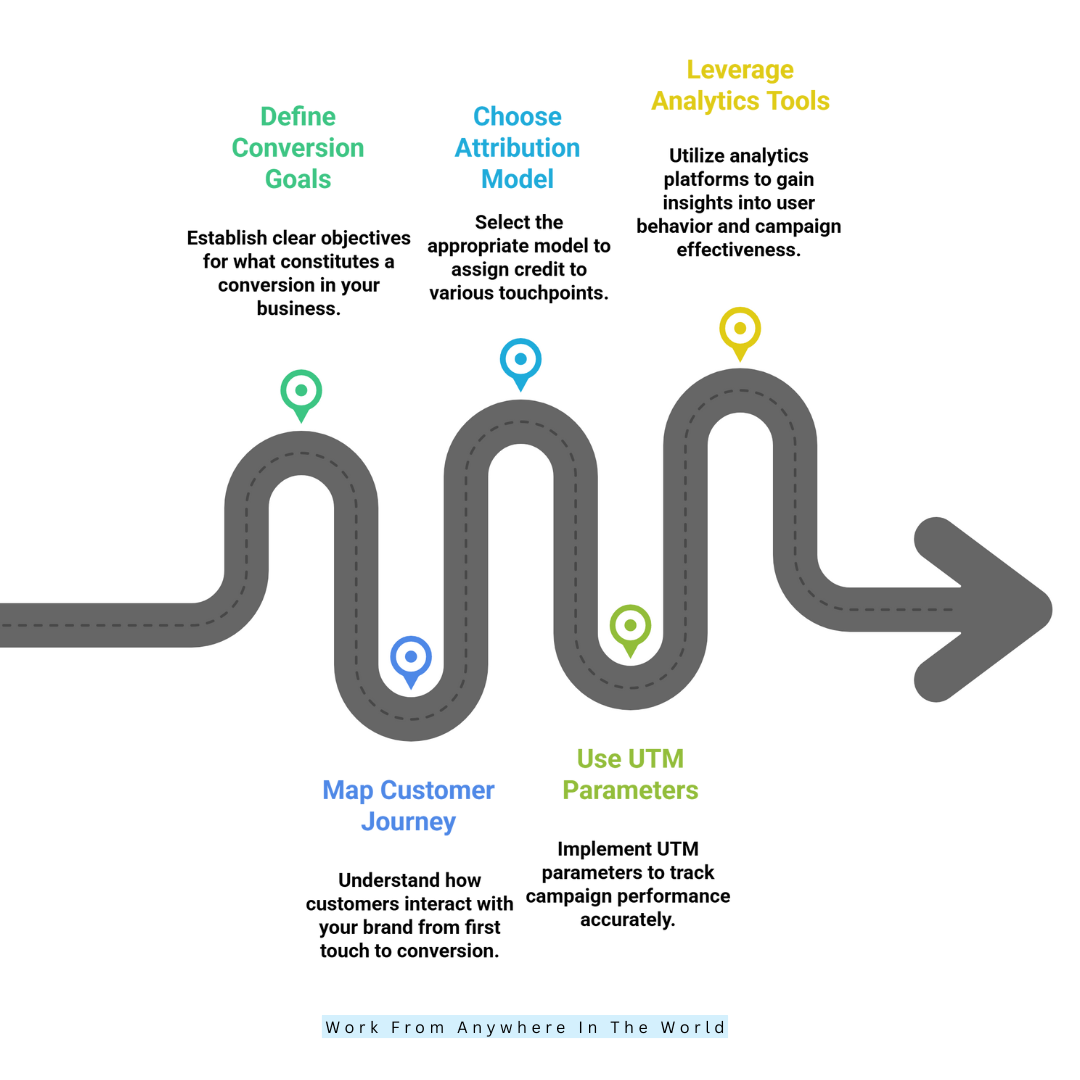
6. Integrate Data Across All Platforms
To get a full view of the customer journey, combine data from your CRM, ad platforms, email software, and analytics tools.
This eliminates data silos and ensures all interactions are connected. Integration platforms or customer data platforms (CDPs) make it easier to consolidate this data into one dashboard.
A holistic view improves attribution accuracy by linking marketing activity with actual outcomes like revenue, pipeline value, or customer lifetime value.
Without integration, you're likely to miss touchpoints or misattribute results. Integrating data ensures consistency across platforms and supports better reporting, optimization, and ROI analysis.
7. Track Multi-Touchpoint Engagement
Modern buyers interact with multiple channels before converting. Tracking every meaningful interaction—website visits, ad clicks, email opens, video views—helps you understand the contribution of each.
Multi-touch attribution recognizes this complexity and distributes credit accordingly. It reveals the strength of your entire marketing ecosystem rather than isolated efforts.
To do this effectively, ensure your tracking system captures session IDs, cookies, or user IDs consistently.
Analyzing these interactions will show how long a customer journey typically lasts, which combinations of touchpoints are most effective, and where strategic improvements can be made across your campaigns.
8. Analyze Attribution Reports Regularly
Attribution isn’t a “set-it-and-forget-it” strategy. Regularly review reports to track performance, identify patterns, and validate your assumptions.
Most tools let you filter data by campaign, channel, or attribution model. Look for recurring trends like which touchpoints appear in the majority of converting paths.
Assess whether attribution weights shift between short-term promotions and evergreen content. Frequent analysis helps you spot underperforming campaigns, refine audience targeting, and adjust your budget accordingly.
Create a cadence—weekly, monthly, or quarterly—to evaluate attribution reports so insights lead to action, not just data collection.
9. Use A/B Testing To Validate Touchpoints
A/B testing helps confirm which touchpoints influence conversions. For example, run two ad versions with different messaging or landing pages and compare how each performs across the funnel.
Attribution tracking within these tests reveals which version better drives meaningful action. You can also test timing, CTA placements, and content formats.
With reliable attribution measurement in place, you’ll clearly see which variations move users toward conversion faster or more cost-effectively.
A/B testing supported by attribution helps optimize individual touchpoints and maximize the effectiveness of your marketing strategies over time.
10. Optimize Based On Attribution Insights
The real value of measuring attribution lies in the ability to act on what you learn. Reallocate your budget toward high-performing channels.
Pause campaigns that fail to contribute to conversions. Enhance touchpoints that consistently appear in successful journeys. These adjustments can significantly improve ROI and reduce customer acquisition costs.
Attribution insights should feed into the ongoing marketing strategy—refining targeting, messaging, and funnel structure.
Review trends over time to understand how user behaviour evolves and how new campaigns influence it. Measuring is only half the job—applying insights ensures your efforts drive measurable business growth.
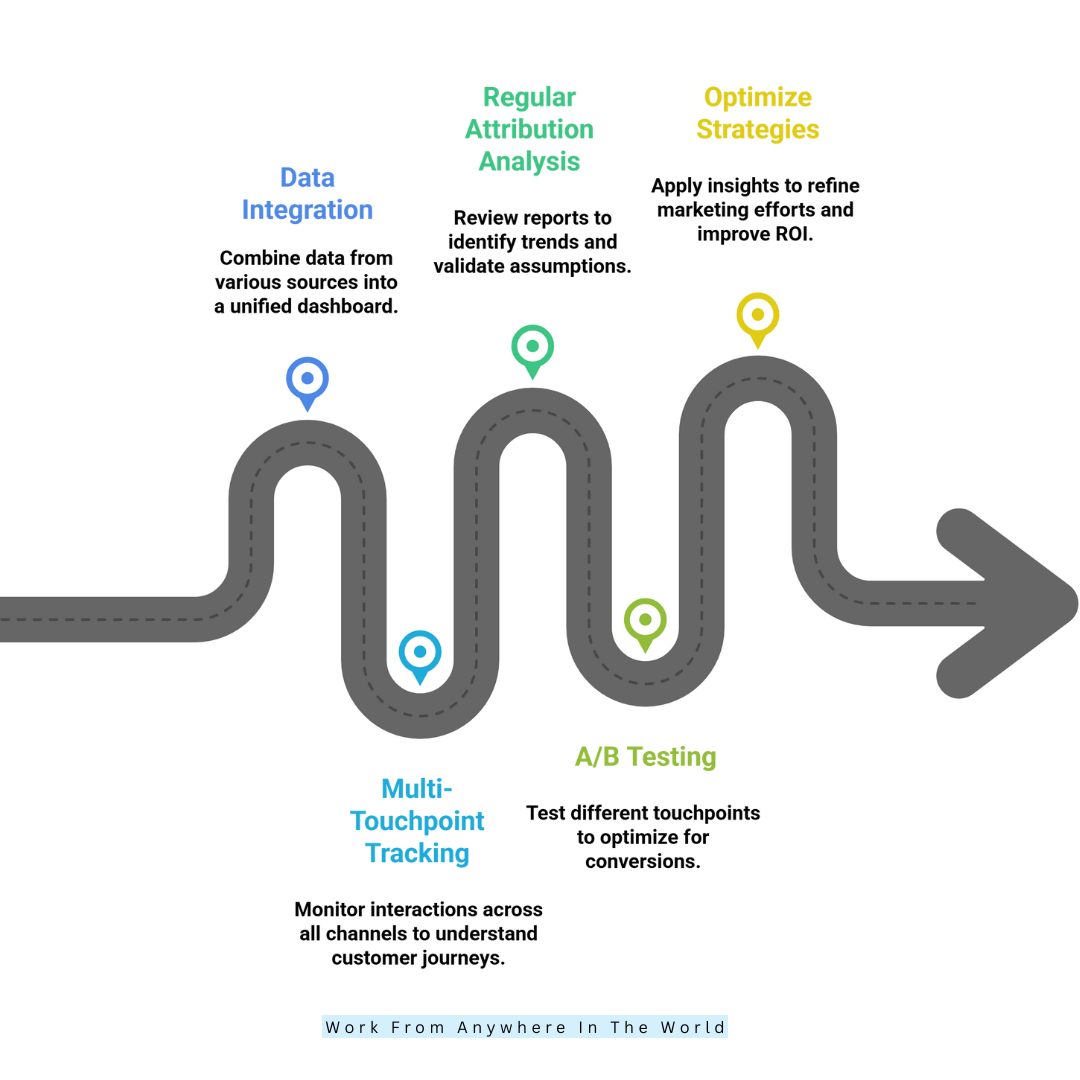
Real-World Example: Multi-Touch Attribution For An eCommerce Brand
Let’s take the example of an eCommerce brand that sells eco-friendly skincare products.
A potential customer named Sarah begins her buying journey on a Monday when she comes across a Facebook ad promoting the brand’s summer sale. She clicks on the ad, explores the site briefly, and leaves without purchasing.
Two days later, she sees a Google Display retargeting ad, reminding her of the brand. Curious, she clicks through again, views a few products, and this time signs up for the brand’s newsletter to receive a 10% discount. Still undecided, she leaves again.
By Friday, she receives an email campaign featuring curated products and her 10% coupon. This final nudge convinces her to make a purchase, and she buys directly through the link in the email.
Sarah’s full journey includes:
- Facebook Ad – First touchpoint creates brand awareness.
- Google Display Ad – Retargeting rekindles interest.
- Email Signup – Lead capture increases engagement.
- Email Campaign – Final push drives conversion.
How attribution models interpret this:
- First-Touch Attribution gives 100% credit to the Facebook ad, emphasizing top-of-funnel effectiveness.
- Last-Touch Attribution gives 100% credit to the email campaign, recognizing the final action.
- Linear Attribution gives 25% to each touchpoint, treating all interactions equally.
- According to Time Decay Attribution, the email receives the highest credit, followed by the Google ad, the email signup, and the Facebook ad.
- U-Shaped Attribution gives 40% credit to the Facebook ad (first interaction), 40% to the email campaign (conversion), and 20% split between the middle touches.
This example demonstrates how different attribution models paint different pictures of marketing effectiveness. By applying the right model, the brand can decide whether to scale up awareness campaigns, invest in retargeting, or double down on email automation—resulting in more intelligent budget allocation and better ROI.
Conclusion
A well-chosen Marketing Attribution Model can transform your strategy, improve your budget decisions, and maximize your campaign performance.
By understanding which touchpoints truly matter, you empower your team to focus on what works.
Whether you're just starting or refining your current approach, now is the perfect time to implement smarter attribution. Stay data-driven, stay agile—and let your marketing efforts lead to measurable success.
I trust you enjoyed this article about the Marketing Attribution Model That Drives Real Results Fast. Please stay tuned for more articles. Take care!
JeannetteZ
Want to Learn How to Build Your Own Home-Based Online Business And Start Making Money Online From Your Comfortable Couch?
Try Wealthy Affiliate!
Your Opinion Is Important To Me
Do you have thoughts, ideas, or questions? I would love to hear from you. Please share your questions, experiences, remarks, and suggestions about the Marketing Attribution Model That Drives Real Results Fast in the comments below. You can also email me at Jeannette@WorkFromAnywhereInTheWorld.com.
Disclosure
This post may contain affiliate links. I earn from qualifying purchases as an Amazon Associate and through other affiliate programs. Please read my full affiliate disclosure.
You may also enjoy the following articles:
Wealthy Affiliate Coupons For Premium Memberships
Wealthy Affiliate Review – Scam or Legit? The Truth Exposed
An Insider Wealthy Affiliate Review
Transform Decisions With Data-Driven vs Data-Informed Insights
Key Marketing Principles For Business Growth





